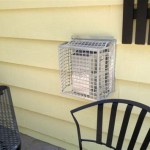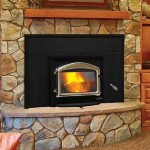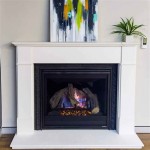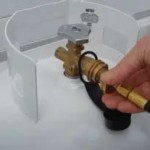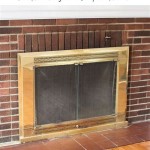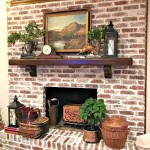Paint Suitable For Inside Fireplace
Selecting the appropriate paint for the interior of a fireplace is a crucial decision that requires careful consideration of several factors. The unique environment within a fireplace exposes paint to extreme temperatures, soot, and potentially corrosive byproducts of combustion. Ordinary paints are not designed to withstand these conditions and will quickly degrade, resulting in peeling, discoloration, and potentially the release of harmful fumes. Therefore, specialized paints formulated to endure high heat and resist fire are essential for a safe and aesthetically pleasing fireplace interior.
The primary function of paint in a fireplace is to protect the underlying material, typically brick or firebrick, from the damaging effects of heat and combustion products. This protection extends the lifespan of the fireplace structure and helps maintain its structural integrity. Furthermore, a properly applied coat of heat-resistant paint can enhance the visual appeal of the fireplace, transforming it from a utilitarian element into a focal point of the room. Choosing the correct paint is paramount to achieving both functional protection and aesthetic improvement.
Ignoring the specific requirements of painting a fireplace interior can lead to a variety of problems. Standard latex or oil-based paints will blister, crack, and peel under high heat. Furthermore, these paints may release volatile organic compounds (VOCs) into the air when heated, posing a health hazard to occupants. The constant degradation of unsuitable paint also creates a maintenance burden, requiring frequent repainting and potentially damaging the underlying brickwork. Therefore, investing in appropriate, high-temperature paint is a cost-effective solution in the long run.
Key Point 1: Understanding High-Temperature Paint Properties
High-temperature paints, also known as heat-resistant or fire-resistant paints, are specifically formulated to withstand extreme heat without degrading. These paints typically utilize specialized resins and pigments that maintain their integrity at temperatures ranging from 500°F (260°C) to 1200°F (649°C) or even higher, depending on the specific product. The selection of a high-temperature paint should be based on the expected maximum temperature within the fireplace, which is typically higher in the firebox itself compared to the surrounding areas.
The key properties of high-temperature paints include heat resistance, adhesion, and durability. Heat resistance refers to the paint's ability to withstand high temperatures without blistering, cracking, peeling, or discoloring. Adhesion is the paint's ability to bond strongly to the underlying surface, preventing it from separating under thermal stress. Durability encompasses the paint's resistance to abrasion, impact, and chemical corrosion from combustion byproducts. A high-quality high-temperature paint will exhibit excellent performance in all three of these areas.
The composition of high-temperature paints typically includes a heat-resistant resin, such as silicone or modified epoxy, combined with heat-stable pigments, such as metallic oxides or ceramic pigments. These pigments retain their color and stability at high temperatures, ensuring that the painted surface maintains its aesthetic appearance. Solvents are also included to aid in application and drying, but it is important to choose paints with low VOC content to minimize health risks and environmental impact.
Different types of high-temperature paints are available, each with its own specific properties and applications. Silicone-based paints are commonly used for fireplace interiors due to their excellent heat resistance and flexibility. Epoxy-based paints offer superior chemical resistance and durability, but may not withstand temperatures as high as silicone-based paints. Ceramic-based paints provide exceptional heat resistance and are often used in industrial applications where extreme temperatures are encountered. Careful consideration of the specific requirements of the fireplace is essential when selecting the appropriate type of high-temperature paint.
Key Point 2: Preparing the Fireplace for Painting
Proper preparation of the fireplace interior is essential for ensuring optimal adhesion and performance of the high-temperature paint. This process involves cleaning the surface thoroughly, removing any loose debris, and addressing any existing damage or imperfections. Failure to properly prepare the surface can result in poor adhesion, premature failure of the paint, and a compromised aesthetic appearance.
The first step in preparing the fireplace is to remove all loose debris, such as soot, ash, and flaking paint. This can be accomplished using a wire brush, a scraper, and a vacuum cleaner. It is important to wear appropriate personal protective equipment (PPE), such as a dust mask and gloves, to protect against inhalation of harmful particles and contact with potentially irritating substances.
Once the loose debris has been removed, the surface should be thoroughly cleaned with a solution of trisodium phosphate (TSP) or a similar degreasing cleaner. TSP helps to remove any grease, oil, or other contaminants that may be present on the surface. The surface should be thoroughly rinsed with clean water after cleaning to remove any residue from the TSP.
Any cracks, holes, or other imperfections in the brickwork should be repaired before painting. Small cracks can be filled with a high-temperature caulk or sealant. Larger holes or damaged bricks may require more extensive repairs, such as patching with refractory cement or replacing the damaged bricks entirely. Allow sufficient time for the repair materials to cure completely before proceeding with painting.
Finally, the surface should be primed with a high-temperature primer specifically designed for use with high-temperature paints. The primer helps to improve adhesion, block stains, and create a uniform surface for the paint. Follow the manufacturer's instructions for application and drying times. In some cases, multiple coats of primer may be necessary to achieve optimal results.
Key Point 3: Application Techniques and Safety Considerations
The application of high-temperature paint requires careful attention to detail to ensure a smooth, even finish and optimal performance. Several techniques can be used, including brushing, rolling, and spraying. The choice of application method depends on the size and complexity of the surface, as well as the painter's skill and experience.
When brushing, use a natural bristle brush for oil-based paints and a synthetic bristle brush for water-based paints. Apply the paint in thin, even coats, working in one direction to avoid brush marks. Allow each coat to dry completely before applying the next coat. Multiple thin coats are generally preferable to a single thick coat, as they provide better adhesion and durability.
Rolling is a faster and more efficient method for covering large, flat surfaces. Use a high-density foam roller for a smooth finish. Apply the paint in a "W" pattern, overlapping each stroke to ensure even coverage. As with brushing, apply the paint in thin, even coats and allow each coat to dry completely before applying the next coat.
Spraying provides the most uniform finish, but requires specialized equipment and skills. Use an airless sprayer or a high-volume, low-pressure (HVLP) sprayer for best results. Thin the paint according to the manufacturer's instructions. Apply the paint in thin, even coats, overlapping each stroke to ensure complete coverage. Wear appropriate respiratory protection when spraying to avoid inhaling paint fumes.
Safety is paramount when working with high-temperature paints. Always work in a well-ventilated area to avoid inhaling paint fumes. Wear appropriate personal protective equipment, including gloves, safety glasses, and a respirator. Follow the manufacturer's instructions for application, drying times, and disposal of waste materials. Keep paints and solvents away from heat, sparks, and open flames. In case of accidental contact with skin or eyes, flush immediately with water and seek medical attention.
After painting, allow the paint to cure completely before using the fireplace. Follow the manufacturer's instructions for curing times. In some cases, it may be necessary to slowly increase the temperature of the fireplace over several hours or days to allow the paint to fully harden and bond to the surface. This process helps to prevent cracking or peeling of the paint during initial use.
Regular maintenance of the painted fireplace interior can help to extend its lifespan and maintain its aesthetic appearance. Clean the surface regularly with a soft brush or cloth to remove soot and ash. Avoid using harsh chemicals or abrasive cleaners, as these can damage the paint. Touch up any areas that show signs of wear or damage promptly to prevent further deterioration. With proper care and maintenance, a properly painted fireplace interior can provide years of reliable performance and visual appeal.

How To Paint The Inside Of A Fireplace Simple Upgrade Maria Louise Design

How To Paint The Inside Of A Fireplace Simple Upgrade Maria Louise Design

How To Prep Prime And Paint A Brick Fireplace Young House Love

How To Paint A Brick Fireplace Beamin Moore

How To Spray Paint Fireplace Interior The Diy Playbook

How To Paint The Inside Of A Fireplace Sarah Joy

Paint Inside Of Your Fireplace South House Designs

Paint The Inside Of Your Fireplace And Change Grout Color

Painting A Drab Fireplace With Modern Look Behr

How To Paint A Fireplace Firebox Fox Hollow Cottage
Related Posts

